How to lock in profits when trading cryptocurrencies?
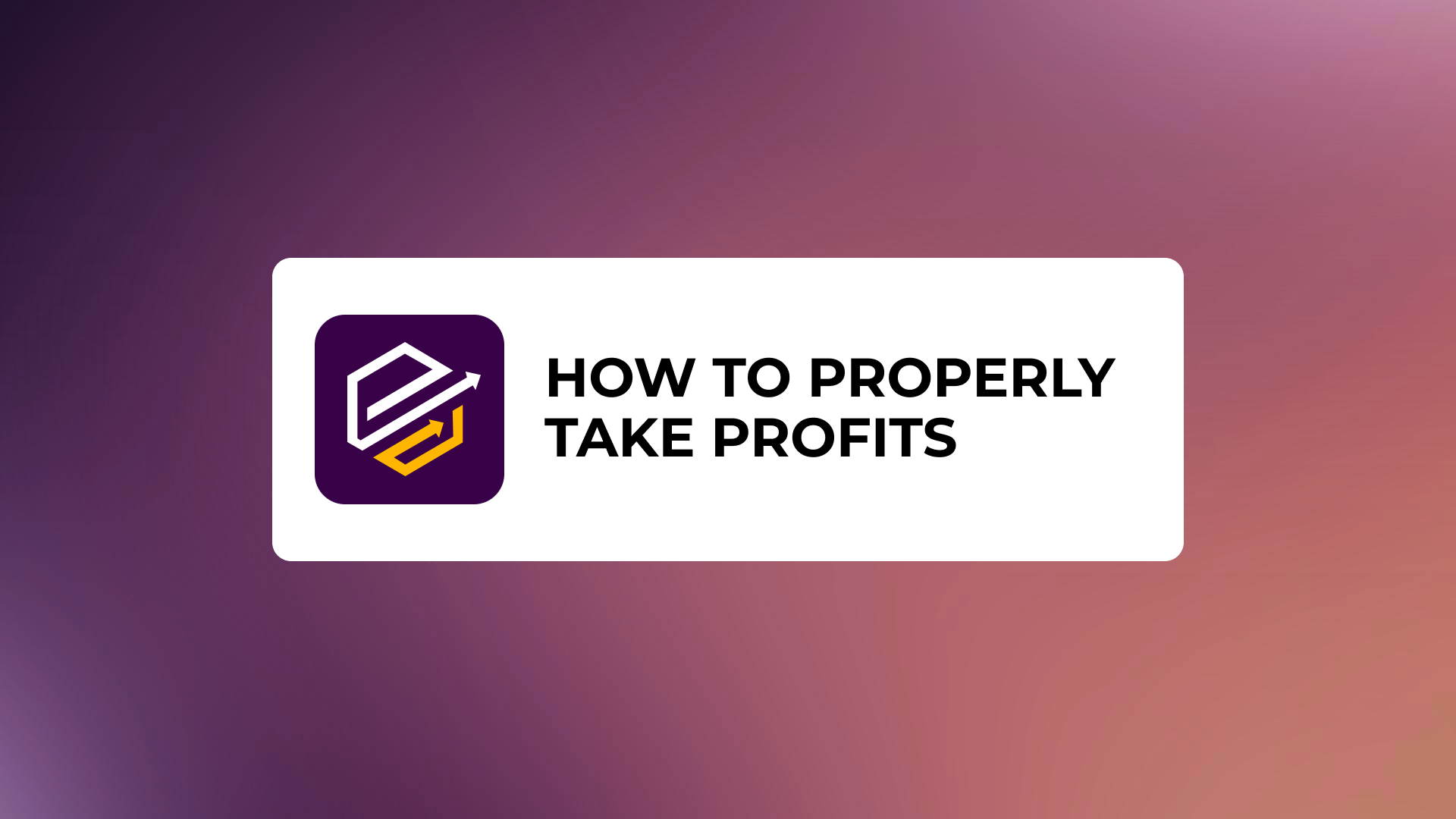
Trading in the cryptocurrency market can be very profitable, but to succeed, you need to manage your positions correctly and fix the profits in time. Many novice traders make the mistake of letting emotions influence their decisions, missing the opportunity to save their earnings. In this article, we will examine in detail what profit-taking is, why it is so important, and what types of profit-taking can be used for effective trading.
Profit-taking is closing a profitable position to fix a positive financial result. In the futures market, a trader can open long and short positions. If you bought a futures contract expecting the underlying asset to grow, this is a long position. Closing a long with a profit occurs by selling the contract at a price higher than the purchase price.
If you opened a short, that is, sold a contract expecting the underlying asset to fall in price, then you need to buy it back at a lower price to fix the profit. The difference between the sale and purchase prices will be your profit.
Taking profits on time helps to:
- Preserve earned capital
- Limit risks and avoid losses when the market reverses
- Maintain psychological stability and discipline
- Free up margin for new transactions
Contents
- Basic principles of profit taking
- Timing for profit taking
- Practical Profit Taking Strategies
- Psychological aspect
- The most common mistakes
- Conclusion
Basic principles of profit taking
Taking profit means exiting a profitable trade in time, closing a long by selling a contract, or closing a short by buying it back. While you hold a position, the profit remains floating, unrealized. It can disappear at any time during an unfavorable market movement. Taking profit converts profit from potential to real, increasing your trading balance.
Pros and cons of full and partial taking profit
A trader can take 100% of the profit at once, closing the entire position or exit it gradually, closing the trade in parts.
- Full closing is appropriate if your goal has been achieved and further movement in your direction is unlikely. But this approach deprives you of the opportunity to earn more if the trend continues.
- Gradual taking profit in parts allows you to receive a guaranteed profit while preserving the potential for more earnings if the price goes further in your direction. However, you have to pay for this with increased risk on the remainder of the position.
The choice of strategy depends on the market situation and your risk appetite.
The influence of market conditions on the decision to close
When deciding to close a position, it is important to consider the “background” and the general state of the market. If the trend is strong and shows no signs of reversal, it makes sense to hold part of the position in anticipation of continued movement. Conversely, holding a long position does not make sense if the market begins to fall actively.
If BTC (the market’s “guide”) begins to fall actively, there is no point in continuing to hold a long position in altcoins since, in 90% of cases, BTC’s high dominance will lead to the entire market repeating BTC’s movement.
Timing for profit taking
Setting goals
Clear goals are the basis of effective profit management. Determine in advance the price levels at which you will take profit. This will help you make objective decisions without giving in to emotions. The main goals for exiting a position:
- The nearest round numbers and psychological levels
- Maximums/minimums of previous movements
- Boundaries of price channels and trend lines
- Fibonacci correction levels
- Daily/weekly/monthly levels
- ATR (Average True Range) of movement
Exchange platforms allow you to place pending Take Profit orders, which automatically close the deal when the price reaches a specified level in the positive zone. For long positions, Take Profit is placed above the opening price of the position, and for short positions, it is below.
To implement Take Profit, exchanges use market orders. Therefore, you act as a taker and pay the corresponding commission (Binance: taker – 0.05%, maker – 0.02%). To exit a position as a maker, you need to place limit orders to close.
For example, having opened a short on BTC at $100,000, you can immediately set Take Profit at $95,000. The platform will close the deal itself if the price reaches this level. Similarly, for a long opened at $95,000, Take Profit should be placed higher, say at $100,000.
The TradeLink Pro platform provides convenient functionality for professional trading strategy analysis. With its help, you can thoroughly study your trading strategy and determine its pros and cons.
Technical Analysis
Technical analysis is your main ally in finding exit points. It helps identify valid levels where the probability of a reversal or a slowdown in the trend is very high. Support and resistance levels are price ranges where the pressure of buyers or sellers usually increases, making further movement difficult.
If the price has approached a strong resistance level, there is a risk of a downward rollback. This is a good moment to take profit on longs. On the contrary, touching the support level during a downward movement signals danger for shorts and indicates the advisability of closing the position.
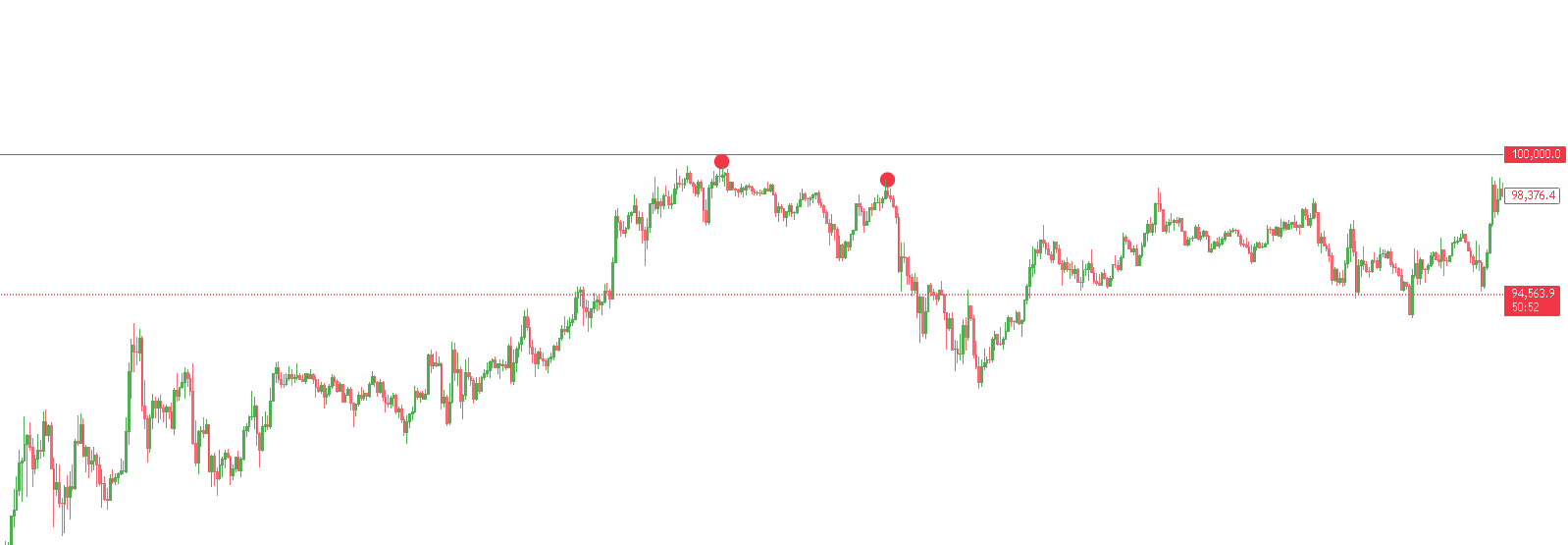
BTC/USDT 1h timeframe
BTC/USDT approached the key level of $100,000 on the 1-hour timeframe, having worked it out as an important psychological boundary. This is a good point for taking profits on longs and a good point at which it makes sense to take a short deal on a rollback to update the nearest short levels.
Indicators: RSI, MACD, Bollinger Bands
Indicators based on mathematical algorithms generate signals about a potential change in the market situation. They help to fix profits on signs of an overbought or oversold market.
- RSI (Relative Strength Index) above 70 signals overbought and imminent downward correction – a signal to fix longs. RSI below 30 warns of the risk of an upward rebound – a reason to close shorts.
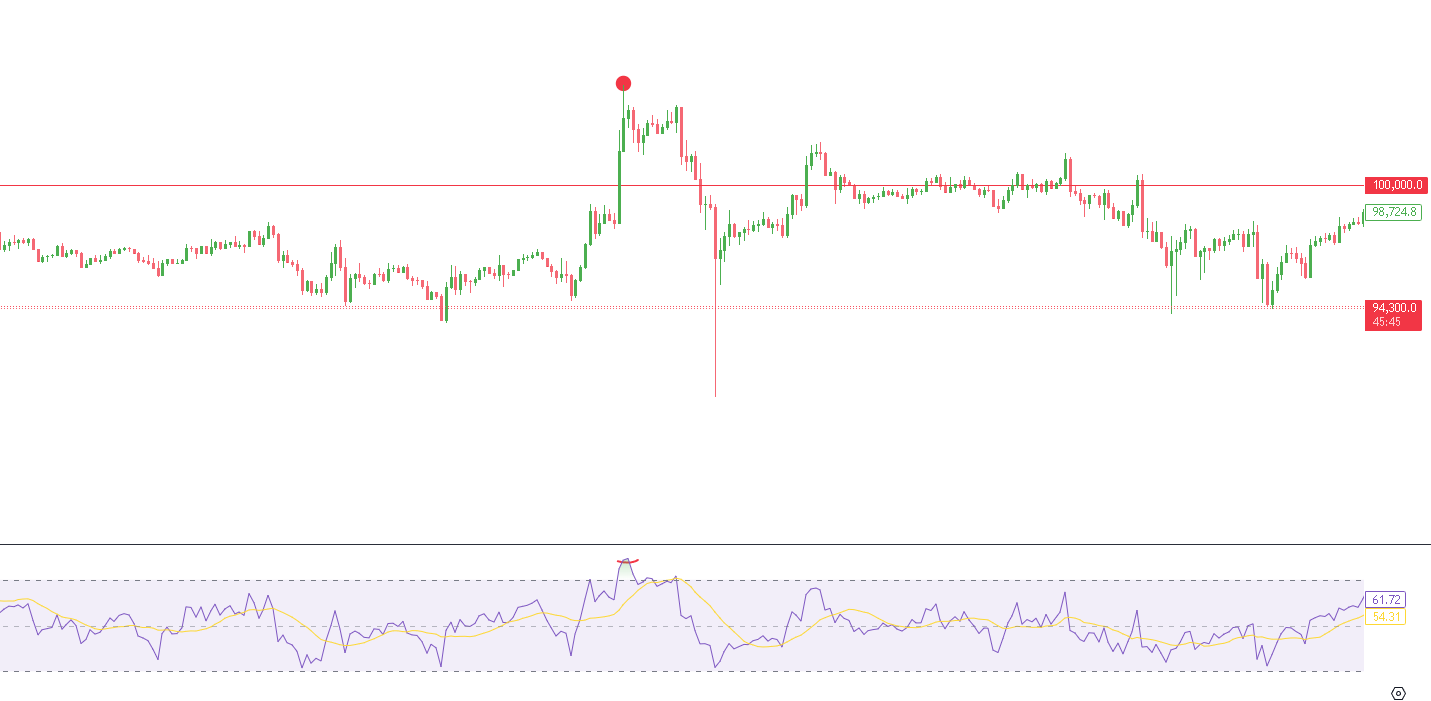
BTC/USDT chart December 5. RSI indicator.- When the MACD (Moving Average Convergence/Divergence) line crosses the signal line from top to bottom, an upward trend reversal is likely, and it is time to take profit on shorts. Crossing from bottom to top hints at a quick downward movement and the need to close longs.
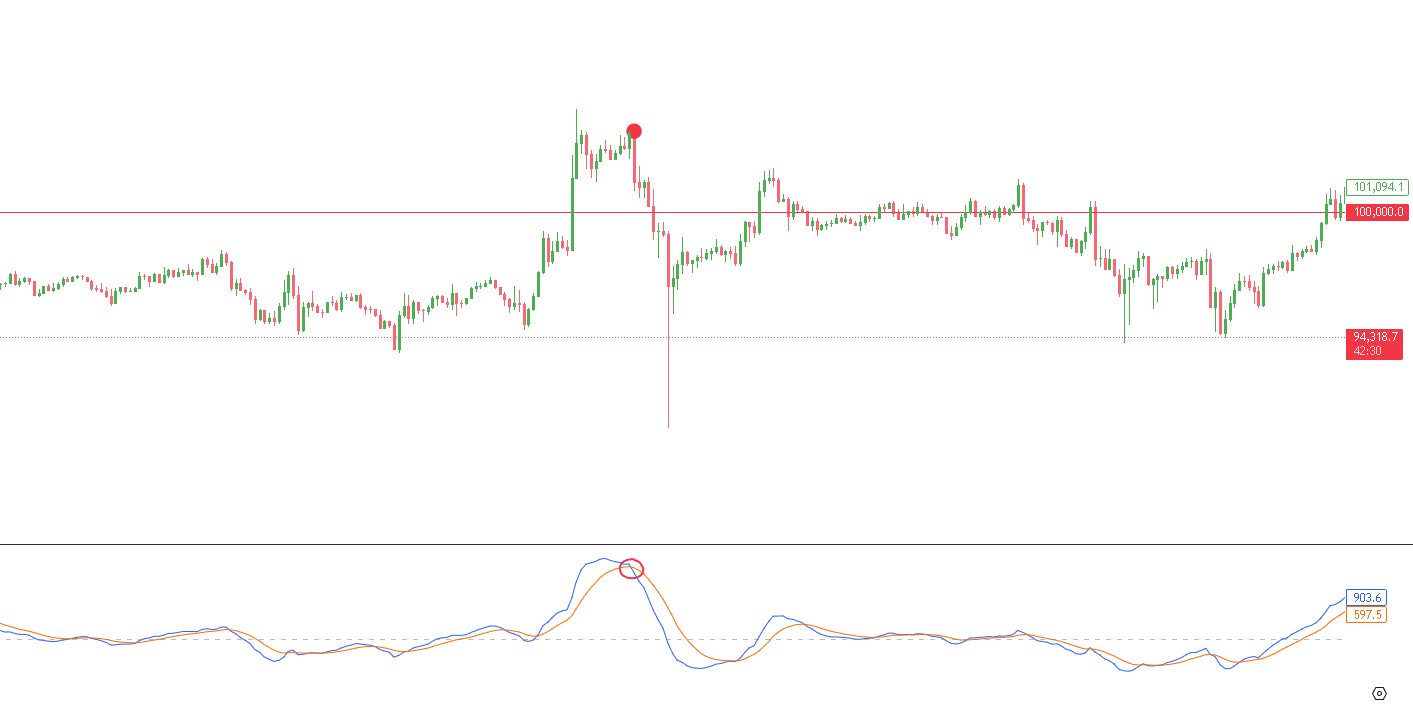
BTC/USDT chart December 5. MACD indicator.- When the price goes beyond the upper boundary of the Bollinger Bands, it indicates a possible downward rollback; when it goes beyond the lower boundary, it indicates an upward rebound.
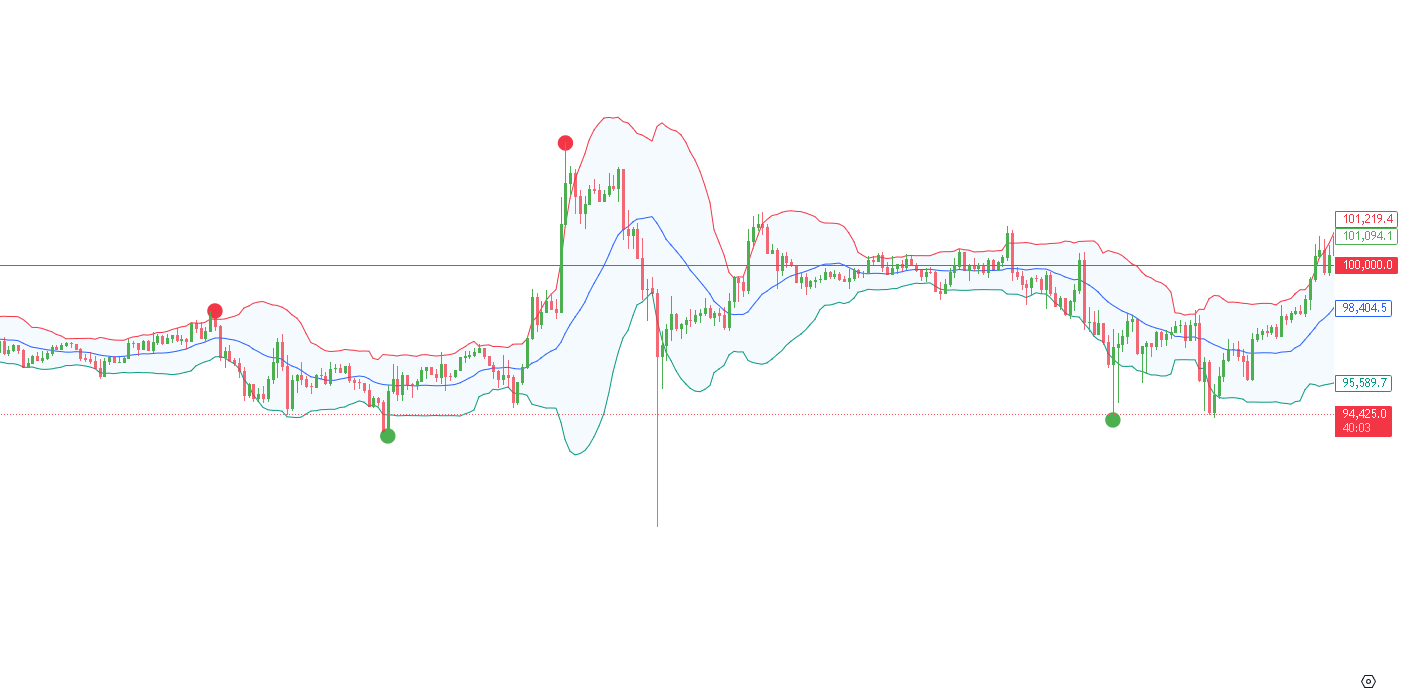
BTC/USDT chart December. BB indicator.
Fundamental analysis
The news background and macroeconomic situation strongly influence the cryptocurrency market.
Positive news for the market (massive purchases of BTC by institutions, ETF approval, positive regulation) accelerates the bullish trend. At such moments, it makes sense to fix part of the profit on longs in case of a short-term correction after the euphoria. Conversely, negative events such as bans, tightening of regulation, delisting of tokens, exchange default, etc., provoke a market collapse.
When trading news, it is important not to rush. In the cryptocurrency market, we often see short and long liquidity takeouts rather than pure directional movement.
Considering the macroeconomic context
The macroeconomy, primarily in the United States, affects the behavior of the crypto market. During periods of monetary tightening, raising Fed interest rates, and strengthening the dollar, investors get rid of risky assets. This puts pressure on crypto and gives reasons to take profits on longs.
On the contrary, in the phase of monetary easing, priority is given to risky investments, which favors the inflow of capital to the crypto market and the retention of long positions.
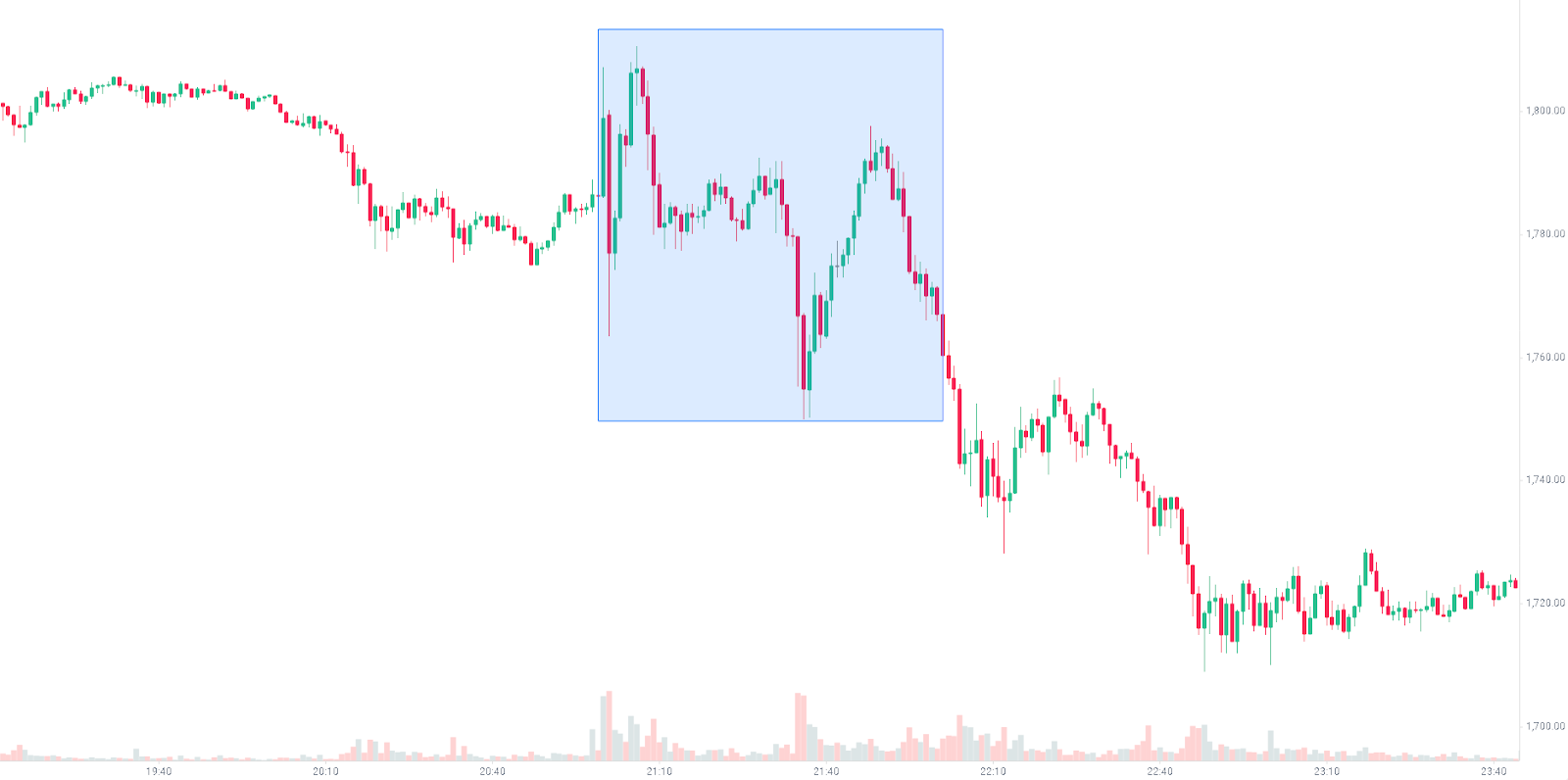
ETH/USDT 1m FOMC Meetings March 22, 2023. Interest Rate Hike by 0.25% (5%)
Practical Profit Taking Strategies
Taking a profit when a specified percentage is reached
Many traders use a simple percentage rule: close a trade when the price moves a certain distance in the desired direction, for example, 2% or 5% of the opening price. This is especially true when trading with leverage when even a small price movement generates a solid profit. However, when calculating risk/profit, always take into account the commission that the exchange charges on the volume of the open position.
Partial profit taking
Closing a position in parts is a flexible tactic that reduces risks and allows profit to “flow.”
Partial take-off most often correlates with liquidity ranges when trading with a trend. You can take 25% of the profit at the nearest resistance level, then another 25% when the next key level is reached, and leave 50% of the position until the final level is reached. When trading positionally, you can close 80% of the position volume according to the system and leave 20% with the idea of further continuation of the asset movement along the trend.
Closing a position in parts allows you to guarantee a profit even with a sudden change in trend and not miss the opportunity to earn more on the continuation of the movement.
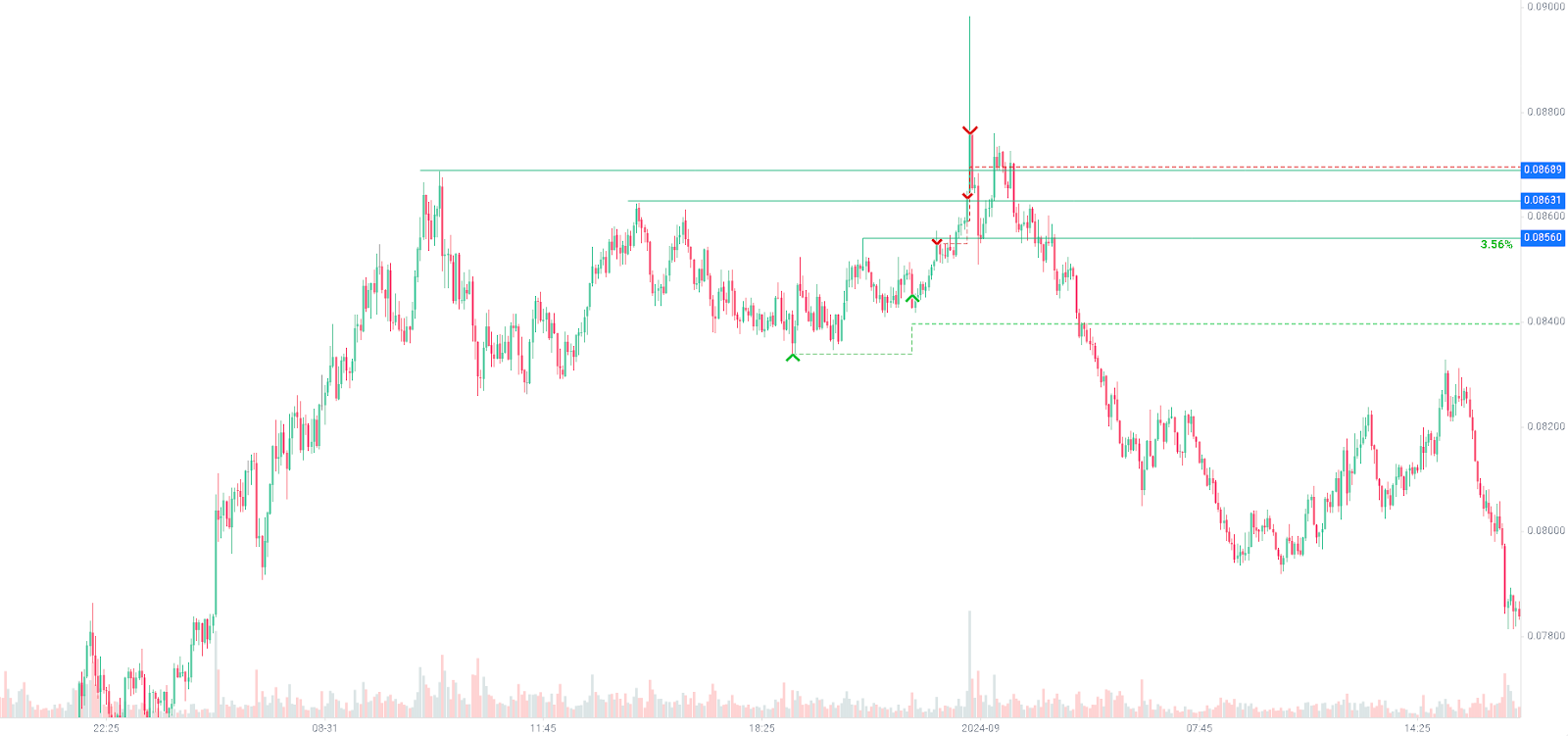
Example of closing a position in parts. RDNT/USDT August 31.
Trailing Stop/Trailing Take Profit
Trailing Stop and Trailing Take Profit are dynamic orders that automatically follow the price with a specified offset as it moves in the direction of your trade. These tools allow you to flexibly manage risks and profits, adapting to changing market conditions.
Trailing Stop
When you open a position, you set a trailing stop at a certain distance from the current price. If the market moves in your direction, the order will crawl after you, maintaining the original distance. When the movement runs out of steam, and the price turns against you, the trailing order will be triggered, and the trade will be closed. Trailing Stop is used to limit losses. You place it on the opposite side of the trade direction:
- When long, the trailing stop is set below the price and moves up following the rising market. If the price reverses downwards, the order will close the position, preventing profit from turning into loss.
- When short, the trailing stop is placed above the price and moves down as the quotes fall. When the downtrend runs out, and the price starts moving up, the trailing stop will stop the losses and close the short.
Trailing Take
The trailing take works similarly but is used to lock in profits. It is placed in the direction of your trade:
- When long, the trailing take is initially set above the opening price and moves up following the price. If the uptrend reverses, the order closes the trade with a profit at the best price achieved.
- When short, the trailing take is placed below the entry point and moves lower and lower as the price falls. When the downward movement runs out of steam, the order locks in profits at the minimum.
The key parameter of trailing orders is the distance from the price (offset). It determines how close to the market the order will follow. The smaller the offset, the tighter the order fits the price. This narrows the permissible drawdown on an open position but threatens the premature triggering of local corrections. Too large an offset moves the order far away from the price and prevents you from fixing your profit in a timely manner.
Position holding time limit
Fixing profit after a certain time has passed since the trade was opened is used to control the duration of holding a position. It is closed if the position has gone into the black within a set period (1 hour, 4 hours, 24 hours). Otherwise, the stop is moved to breakeven, giving the trade another time cycle.
This strategy is suitable for short-term trading, helping to average the results and catch local price movements.
Psychological aspect
The influence of emotions on decisions about fixing
Emotions are the worst enemy of a trader. Under the influence of greed, you can hold a profitable position for too long and end up with a loss instead of a profit. Fear of missing out on potential profit (FOMO) provokes a refusal to close a deal in a timely manner in the hope of getting more.
How to control the emotional factor:
- The main weapon against destructive emotions is a trading plan and discipline.
- Create a clear algorithm for entering and exiting positions, which you will not go beyond under the influence of momentary emotions.
- Set a daily drawdown, upon reaching which you stop trading regardless of the market situation. Usually, a daily drawdown is set at 5 to 10 percent of the trading deposit.
- Control the number of attempts to work out one situation. No more than 2-3 attempts.
The most common mistakes
Taking Profits Too Early
Newbie traders often make the mistake of taking profits too early, feeling relieved at the first sign of profit. They close the position after a small move in their favor, missing out on the lion’s share of potential profit. Do not rush, let the move develop. If there are no clear reversal signals, hold the trade until the intended target is reached.
Excessive expectations from the market
The other extreme is the desire to take huge profits from each trade. Greedy traders do not close positions at reasonable levels, hoping to earn hundreds of percent from one trade. This usually leads to losing all profits on corrections. Be more modest in your expectations and be content with the real profit that the market gives, instead of hypothetical ones.
Remember: The market can remain irrational longer than you can stay solvent.
Lack of a plan and susceptibility to emotions
Opening trades chaotically without a clear strategy for taking profits dooms you to emotional swings and mistakes. If there is no algorithm for closing positions, you will be torn between greed and fear, making impulsive decisions. Create a trading system that includes goals, conditions, and fixing methods, and strictly adhere to it.
Conclusion
The art of profit-taking is a skill of a successful trader. Timely closing of profitable positions allows you to effectively manage capital, limit risks, and earn consistently in a volatile market. Combining profit-taking strategies based on technical and fundamental analysis, discipline, and psychology will significantly increase your chances of success.
Fix profit systematically and consistently, and your deposit grows steadily. Remember that lost profit is better than lost profit on a reversal. Take money from the market, be proud of the result, and move to new heights!